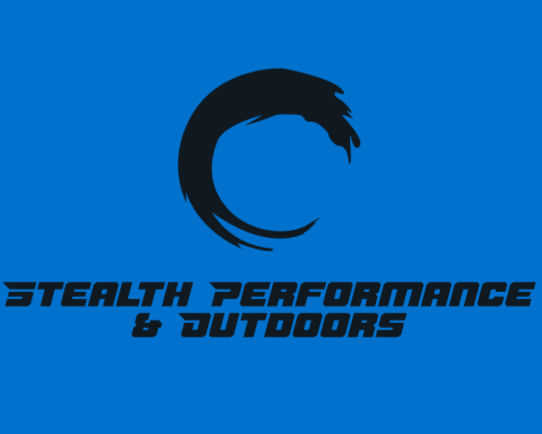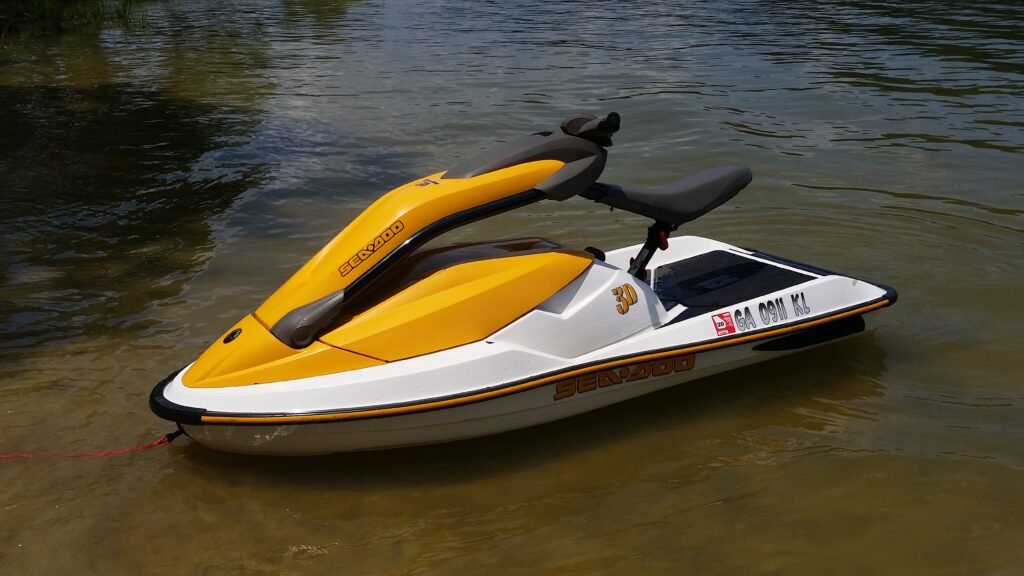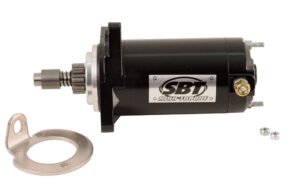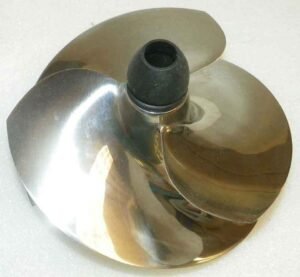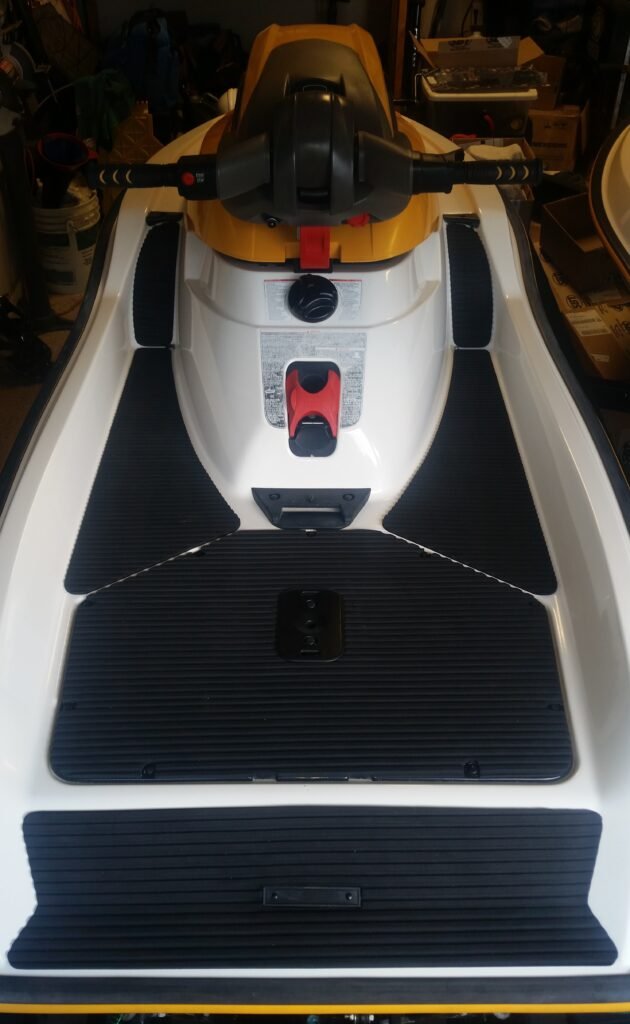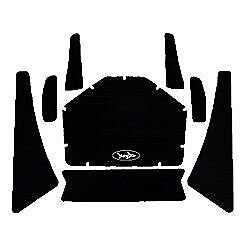This post may contain affiliate links, which means that I may make a small commission off items you purchase at no additional cost to you. Please see my terms of use page for details.
Table of Contents
ToggleIntroduction to the Sea-Doo 3D
The Sea-Doo 3D, introduced in 2004 and marketed from 2005 to 2007, stands out as one of the most exotic and innovative personal watercraft (PWC) models ever built by Sea-Doo. This remarkable machine offered an unprecedented level of versatility, presenting riders with five distinctive riding positions. It utilized the hull from the esteemed XP series and was available with either a 787 RFI (110 HP) or a 947 DI (130 HP) engine configuration.
This article delves into the depths of this unique stand-up/ sit-down hybrid Sea-Doo, providing insights into its design, riding positions, engine performance, and the challenges that led to its discontinuation.
The Birth Of The Sea-Doo 3D: Concept and Development
Crafted by a dedicated team of stand-up PWC enthusiasts at Sea-Doo’s R&D development center in Florida, the Sea-Doo 3D emerged as a response to the evolving PWC market. As the industry trended towards larger, less maneuverable 3-seater skis, there arose a gap for a more playful and agile watercraft, especially appealing to younger thrill-seeking riders.
Originally conceived as a side project named “Barracuda,” the prototype was pieced together from various Sea-Doo parts, incorporating custom-made elements. Its success in initial trials led to the formal approval of the project by Sea-Doo’s management, ushering in the official development of the Sea-Doo 3D.
The Adaptable Seadoo 3D: Your All-in-One Jet Ski Experience
The Seadoo 3D, renowned for its adaptability, offers five distinctive riding positions tailored for individual enjoyment rather than accommodating multiple riders. Despite its versatile design, it’s crucial to note that the Seadoo 3D is engineered exclusively for single-person riding experiences.
This watercraft’s primary focus remains on providing an exhilarating and personalized ride for one rider. The versatility stems from its ability to transform between the Kart style, the MOTO seat style, and the fully stand-up style, among other options, catering to a solo rider’s preferences and riding style variations
Understanding the Sea-doo 3D’s Purpose
Designed primarily for an exciting and fun-filled solo ride, the Sea-doo 3D is not intended for accommodating multiple passengers or carrying substantial gear. Its versatility lies in its ability to offer various riding positions for a sole rider’s enjoyment rather than catering to storage or multi-rider needs. As you can see below the storage area was very small, maybe enough room for a small drink, DESS key, and registration info.
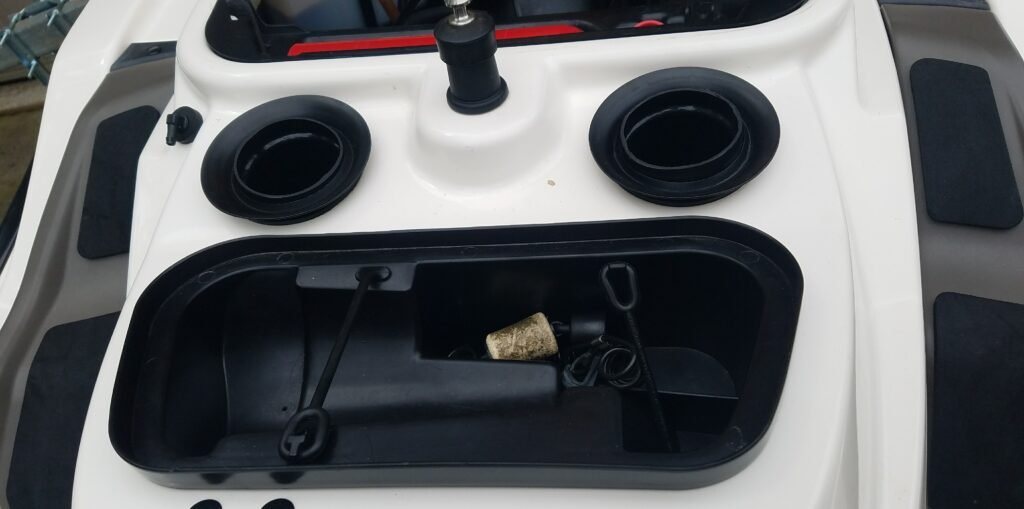
The Sea-doo 3D stands as a remarkable choice for individuals seeking an adrenaline-pumping and personalized jet ski experience, focusing solely on the thrill of riding and maneuvering through the water in diverse styles. Its compact design and emphasis on individual riding dynamics make it an ideal choice for those passionate about personal watercraft performance and excitement.
Another cool feature of the Seadoo 3D was the manual knob activated trim nozzle, as you can see in the picture below. It may not have been as easy to adjust as the electric button operated or the manual remote cable operated style on prior models but it was dependable, because it had minimal mechanical parts.
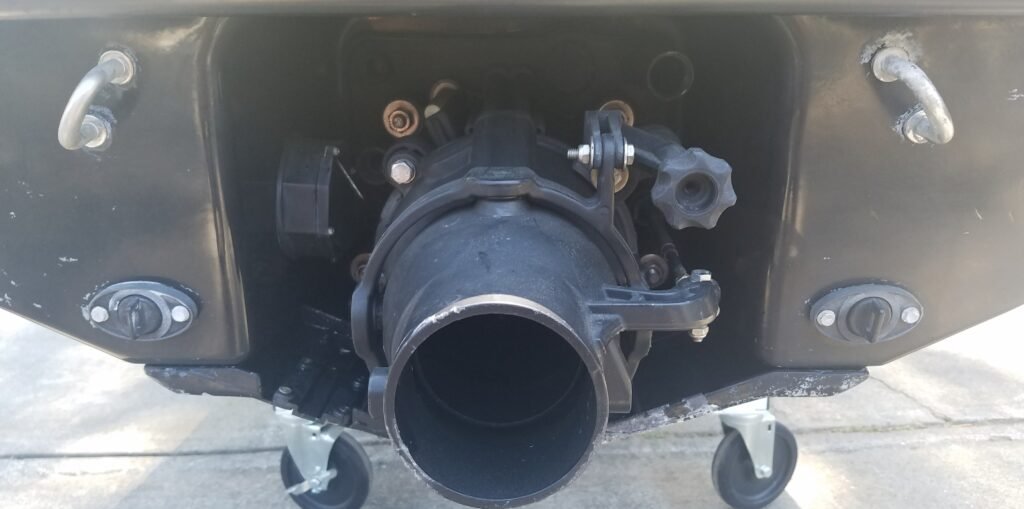
The 2004-2005 Sea-doo 3D Power Plant: The 787 RFI Engine
Overview of the 787 RFI Engine
The Sea-Doo 787 RFI engine marked a significant leap in personal watercraft technology during a pivotal era of fuel-injected engine development at Sea-Doo. As a 2-stroke, 2-cylinder fuel-injected powerhouse, the 787 RFI represented a shift towards reliability and enhanced performance.
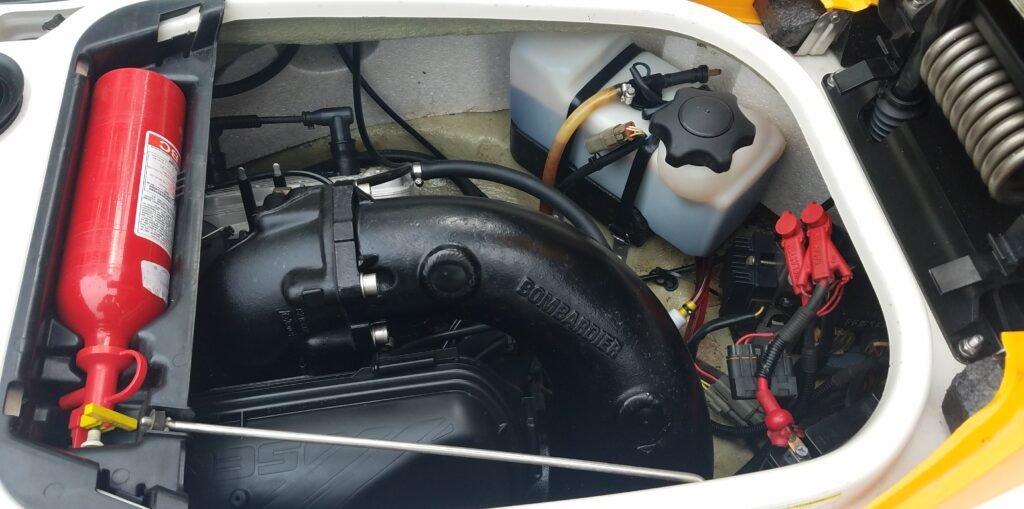
Key Components of the 787 RFI Engine
At its core, the 787 RFI engine integrated the Rave (Rotax Adjustable Variable Exhaust) valves, dynamically managing exhaust port timing to optimize engine efficiency and power output. Moreover, the Rotary Valve, crucial in Seadoo 2-stroke engines, meticulously regulated the air-fuel mixture intake into the cylinders, ensuring precision in fuel delivery and combustion.
The engine boasted a sophisticated fuel injection system, delivering exact amounts of fuel into the cylinders for improved throttle response and overall performance.
If your Seadoo 3D has developed a problem starting, taken on water and the starter is shot and not working, you can get a replacement New starter below:
Performance and Efficiency
Recognized for its spirited performance and efficiency, the 787 RFI engine, with a displacement of 782cc, provided ample power for various Sea-Doo watercraft models. Balancing power and fuel economy, it enabled riders to experience thrilling speeds while maintaining optimal fuel consumption.
Technological advancements in the engine, including Rave Valves, Rotary Valve, and the fuel injection system, not only enhanced performance but also reduced emissions, aligning with stringent environmental regulations. This blend of reliability, power, and environmental consciousness solidified the engine’s significance in Sea-Doo’s innovative lineup.
Evolution to the Rotax 947 DI Engine
Initially powered by the Rotax 787 RFI engine, the Sea-Doo 3D’s performance was perceived as lackluster, producing 110 HP and reaching a top speed of 52-54 mph. However, in 2006, the model underwent an upgrade to the more robust 130 HP Rotax 947 DI engine. This enhancement pushed the craft’s top speed to 62 mph, but also resulting in a slightly heavier watercraft.

The Versatile Sea-doo 3D: Exploring The 5 Different Innovative Riding Positions
The Sea-doo 3D from 2004-2007 stood out in the personal watercraft world for its adaptability, offering riders five distinct riding positions, catering to various preferences and riding experiences. Each configuration provided a unique way to enjoy the water, making the Sea-doo 3D a versatile choice for water enthusiasts.
VERT Position
The Sea-Doo 3D was a versatile watercraft that catered to various riding styles, among which the VERT configuration stood out. This setup mirrored the conventional stand-up personal watercraft (PWC), providing a unique yet familiar experience for riders. Thanks to its sit-down hull design, standing on the rear flat area while operating the ski became a breeze, granting maneuverability even when stationary. Its outstanding stability made it particularly appealing to beginners and larger riders, facilitating easy navigation through no-wake zones.
Embracing the stand-up style, the Sea-Doo 3D VERT position boasted a notably larger foot pad area than its predecessors in the stand-up jet ski category. This extended platform delivered heightened stability and enhanced control, catering to those seeking a well-balanced stand-up adventure on the water.
Equipped with a fully movable handle pole complete with safety features like an engine kill switch with safety lanyard and thumb-style throttle trigger, riders enjoyed seamless maneuvering, ensuring precise control and responsive handling. The handle pole also housed a multi-function meter, offering valuable indicators such as a low level oil warning light and diagnostic warning light. Premium models even included a 3-bar fuel gauge, adding both convenience and an extra layer of safety to the riding experience.
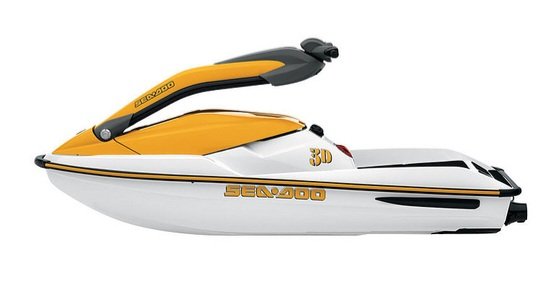
SHOQ Position
In the SHOQ setup, a locked handle pole enhanced stability and control, reducing rider fatigue. This configuration featured a special shock absorber between the top deck and the handle pole, delivering a more comfortable stand-up experience. For most traditional standup jetski riders the VERT position was preferred over the SHOQ position.
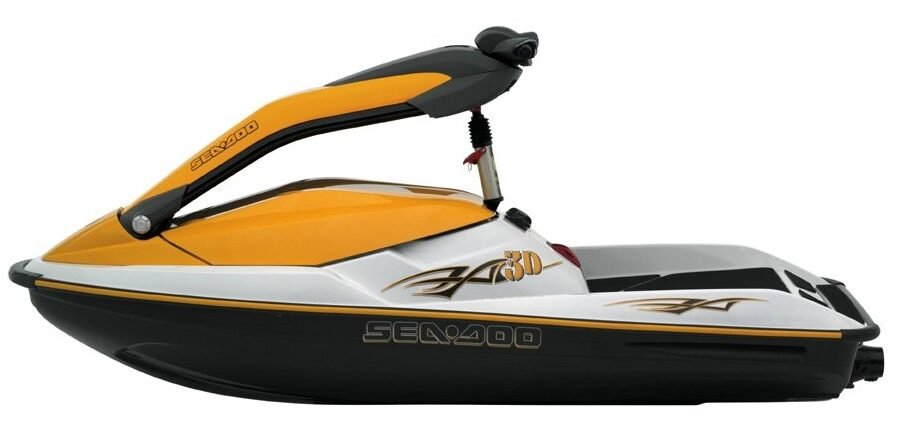
KNEE Position
Allowing riders to operate the 3D from a kneeling position, the low center of gravity provided a kneeboard-like experience, adding diversity to the riding options. This riding position was considered to be most comparable to riding on a kneeboard being pulled by a rope and handle off the back of a boat.
MOTO Position
The MOTO position on the Sea-Doo 3D brought forth a distinctive feature by incorporating a seat reminiscent of a dirt-bike seat positioned above the rear deck, resembling the setup seen in the sit-down Sea-Doo XP models. However, despite its innovative design, the discomfort associated with this unique rather tough cushion seat and its proximity to the handlebars stood out as notable drawbacks of this configuration.
A standout element of the Sea-Doo 3D’s uniqueness was the inclusion of a concealed banana seat cleverly tucked away within the handle pole. This MOTO seat could be easily flipped out and secured into a fixed socket located just above the rear deck of the watercraft’s hull. This transition allowed riders to adopt an upright seated riding style, comparable to a more traditional seated experience.
This configuration catered to riders seeking stability and control while navigating through the water, offering an alternative riding position that departed from the standard stand-up or conventional sit-down styles typically associated with personal watercraft.
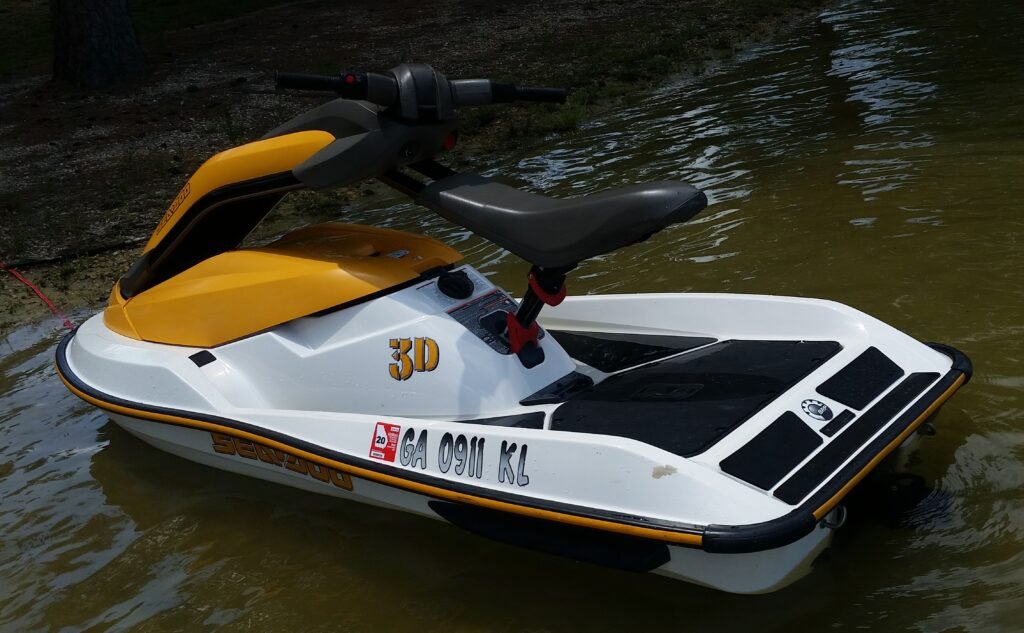
KART Position
The Kart style position on the Sea-Doo 3D was a remarkable feature that transformed the watercraft into a go-kart-like experience by introducing an optional bucket seat. This unique setup offered riders a radically different yet enjoyable way to navigate the waters. However, it was recommended primarily for calmer waters due to potential discomfort in the lower back when encountering rough conditions.
A highlight of the Sea-Doo 3D was its adaptation for Kart-style riding, achieved through the incorporation of a removable lock-in bucket seat. This seat was ingeniously designed to securely latch onto the standing floor using a lever-style mechanism and had optional removable footrests, catering to riders of varying heights and preferences. With its reclined sitting posture, this configuration provided a relaxed and comfortable experience, ideal for leisurely cruises or casual rides along the waterways.
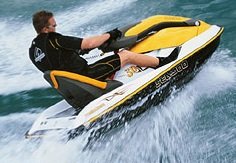
Image property of Boats.com.
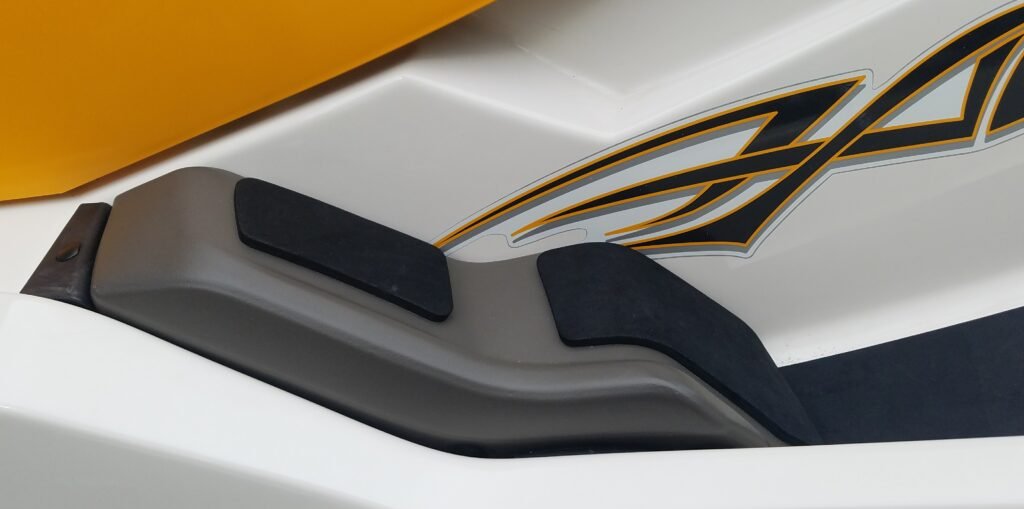
If you are experiencing jet pump propulsion issues then you should consider checking and replacing your impeller and wear ring. You can purchase a new Solas impeller from Amazon below:
Challenges and Discontinuation
Despite its innovative design, the Sea-Doo 3D faced several issues that hindered its popularity and led to its discontinuation. Notably, its “Jack of all trades, master of none” identity left it heavier and bulkier than traditional stand-up models, affecting handling and maneuverability.
Additionally, engine reliability became a significant concern, with the 787 RFI and 947 DI engines facing durability and overheating issues, compounded by the craft’s design flaws, including an uneven weight distribution and an imbalanced hull.
Ultimately, these challenges marred the Sea-Doo 3D’s reputation, contributing to its demise after a brief three-year production run.
Conclusion
The Sea-Doo 3D encapsulated innovation and versatility, allowing riders to explore multiple riding positions, from seated comfort to thrilling stand-up adventures. Its groundbreaking design catered to a spectrum of preferences, appealing to both beginners and seasoned enthusiasts. Alongside this adaptability, a range of optional accessories like custom traction mats, performance impellers, and personalized graphics enabled riders to tailor their experience to match their skills and tastes.
Despite its commendable features, the Sea-Doo 3D faced challenges that curtailed its widespread success. Issues with the craft’s design, including an uneven weight distribution and performance concerns with its engines, hindered its reputation. These setbacks, compounded by its hybrid nature that didn’t fit neatly into either stand-up or sit-down categories, led to the 3D being seen as a “Jack of all trades, master of none” in the PWC market.
Nevertheless, the Sea-Doo 3D remains a testament to Sea-Doo’s commitment to innovation. Its introduction brought a new dimension to personal watercraft, offering unparalleled versatility and diverse riding experiences. Despite its flaws, this unique model left an indelible mark in Sea-Doo’s history, showcasing the brand’s willingness to push boundaries and explore new possibilities in the ever-evolving PWC industry. While it may not have attained widespread popularity, the Sea-Doo 3D stands as a testament to the pursuit of innovation and experimentation in watercraft design.
If you want to update and maintain your Sea-doo 3D it is a good idea to replace your traction mats. Below is what they will look like with the Blacktip style Black Cut Groove mats. The Black Cut Groove is a very traditional jetski style. Take a look at the other colors and styles at the link below:
Disclosure: As an Amazon Associate, I earn from qualifying purchases.
